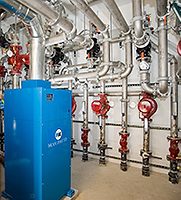More than just Lambeau Field

From the start, when Green Bay Packers' management decided to renovate Lambeau Field in the early 2000s, they called on mechanical contracting businessman, David LeMay. During the stadium tour that LeMay gave me and PHC News Columnist Dan Foley in the fall 2015, he also took us for a walk across Oneida Avenue. There, we were able to see the work his firm, Tweet/Garot, did to the team’s practice field, which is named after one of football’s legendary linebackers.
The Packers began renovating the Ray Nitschke Field in fall 2008, replacing the existing artificial turf with a hybrid bluegrass surface almost identical to the turf at Lambeau. Now both fields, along with some of its hardscape surfaces, are heated with about 26 miles of PEX tubing.
Before the Nitschke Field renovation, the Packers held most of its winter practices at an indoor facility to avoid Wisconsin’s freezing temperatures. A 2004 NFL Players Association survey confirmed that players overwhelmingly prefer natural surfaces to synthetic because they believe synthetic fields are more likely to contribute to injury. However, natural turf maintenance comes with its own set of challenges, particularly in cold climates like Green Bay, where frozen ground does little to extend the career of an NFL player.
Fans assume that heating the field is all about keeping the players warm and dry, but, in fact, a radiant-heated sports field is just as much about grass – or more specifically, the grass roots.
Once a team commits to a natural turf surface for the sake of the players, maintaining the root system throughout the year becomes top priority. That’s where proper design and control become non-negotiable.
Tweet/Garot, Inc. designed and installed the field piping and mechanical system for Nitschke Field, working closely with a sports field design specialist that installed the drainage, irrigation, and turf system.
The design includes six separate zones that heat a total of 4,400 square yards of the practice field. Approximately 140,000 feet of 3/4-inch PEX tubing was installed six inches below the playing field sur- face and also in some select concrete areas of the stadium. The system is designed to handle 1,000 gallons per minute of heating flow.
Six custom-built, high-density poly-ethylene (HDPE) manifolds serve the system. Each of these manifolds includes evenly spaced supply and return adapters for the 3/4-inch and 5/8-inch PEX tubing. Because the Nitschke system has such a high volume, four-inch headers were included on each manifold, each capable of directing its share of the water/glycol mixture that heats the field and concrete areas. Three 3-million-BTU boilers heat the fluid, which is pumped by variable speed pumps. A hydronic separator enables the primary and secondary circuits of the system to by hydraulically independent of each other.
“To save energy, the system is designed to operate at the lowest possible supply temperature,” LeMay said. “We put together an extensive temperature reset schedule based on data we gathered from the Lambeau Field, which we also designed and installed.”
This schedule eliminates the guesswork associated with selecting set points for the system, which is designed to maintain specific root temperatures that vary throughout the year. Typically, the system maintains a soil temperature anywhere between 40°F-60°F. The target temperature varies depending on the time of year.
Temperature variation must be gradual so as not to shock the root system, which means carefully bringing the temperature down to 40°F degrees in the winter and gradually up again in the spring for reseeding. The direct digital controls for the radiant system are integrated within the existing building automation system at Lambeau Field.





